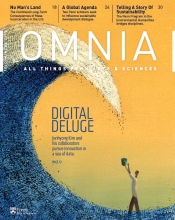The Claw! Descending into a congregate of plush toys, the claw pulls out a single prize and isolates it from the pack. We are all familiar with the popular arcade game; now imagine such a mechanism put to use at the atomic level. Eric Schelter, associate professor of chemistry, has discovered a molecular claw can be handy for separating rare earth metals.
Though employed in a number of industrial applications—cell phone batteries, wind turbines, and electric car engines—rare earths are difficult to collect and concentrate. The metals are chemically quite similar.
Schelter has spent his career considering the problem of how to improve the current, laborious process of separating rare earth metals from mined ores while at the same time investigating how to recycle the metals already unearthed. “At this point there are more rare earths in landfills than there are in global reserves in the ground in rocks,” says Schelter.
For the past five years the Schelter lab has focused on selectively changing the charge on one type of ion in a mixture of metal ions, hoping to use that unique charge as a separation method. While testing a molecule they had synthesized for this purpose, Schelter’s students noticed that one metal ion complex had different solubility properties.
“It started as a simple inorganic coordination chemistry project with the end goal of potentially improving rare earth separations,” says Justin Bogart, a graduate student assigned to the project. “I don’t think either of us had any idea of where the project would end up.”
The compound Schelter’s students made is known as a ligand, which attaches to metal ions dissolved in a solution. But this ligand does something unique. When it encounters a neodymium ion the three prongs of the ligand open just enough to accommodate the dissolved metal cations.
“The nature of the ‘tripod’ ligand is such that it grabs onto the ion like a little claw, and depending on the size of the ion it fits into the claw in a slightly different way,” says Schelter.
The spacing of the tripodal ligand with neodymium nestled in the center results in a structural arrangement that allows a second ligand to join the ligand–metal ion complex. Two ligands linked to the metal ion exhibit completely different properties than just one. When the tripodal ligand is attached to a different metal ion its size will not allow a second ligand to connect. This difference in chemistry is harnessed to separate neodymium from other metal ions in solution.
What is remarkable about this accomplishment is that neodymium is being isolated from other rare earth metals based on a minuscule size difference, a couple hundredths of an Angstrom (10-10 meters).
“It’s a really hard problem,” says Schelter. “That’s part of the reason we don’t have an efficient process for doing this.”
So far Schelter’s group has been able to separate neodymium from dysprosium—key elements used in very strong permanent magnets—in laboratory experiments. The group plans to look for other size-selective ligands and to use the tripodal ligand to separate other rare earth pairs. They will also explore methods to separate yttrium from europium—a mixture disposed of after mercury is removed from compact fluorescent bulbs.
Schelter notes that the group was lucky to discover the size-specific claw while looking for a charge separation method. “This is how research works much of the time. Maybe it wasn’t exactly how we planned to do the separation, but it works.”




